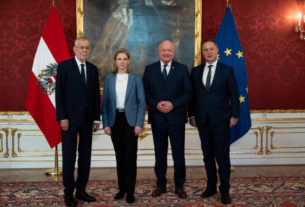On March 13, 2025, Ukraine’s top military commander stated that forces will continue fighting in Kursk for as long as necessary. The comments reflect Ukraine’s determination to hold its ground in the ongoing war.
The Kursk region, located in western Russia near the Ukrainian border, has been a focal point of recent clashes. Ukrainian forces have carried out cross-border operations targeting Russian military positions.
“This is a strategic necessity,” the commander said in a press briefing. He emphasized that Ukraine’s actions aim to weaken Russian supply lines and disrupt military movements.
Russian officials have condemned Ukraine’s presence in Kursk. They accuse Ukrainian forces of escalating the conflict beyond their own territory.
The fighting in Kursk follows a series of drone and artillery strikes by Ukraine in early March. These attacks have reportedly damaged key Russian infrastructure and military assets.
Moscow has vowed to respond with increased military action. Russian officials claim that Kursk’s security is a priority for their ongoing war efforts.
Ukraine’s strategy has shifted toward targeting border regions in recent months. Military analysts believe this approach aims to pressure Russia’s logistics and force troop reallocations.
The Ukrainian government has not disclosed specific troop numbers involved in the Kursk operations. However, reports indicate that elite units are conducting raids deep into Russian-held areas.
Casualty figures from the ongoing battles remain unconfirmed. Both sides have released conflicting reports about losses suffered in the region.
Ukraine’s ability to sustain operations in Kursk depends on continued military aid from Western allies. The U.S. and NATO countries have provided weapons and intelligence support.
The Russian military has reinforced defenses in Kursk and neighboring Belgorod. Satellite images show an increase in fortifications and troop movements.
Some Western officials have expressed concerns about the risks of fighting on Russian soil. They fear it could lead to a broader escalation of the war.
Despite the risks, Ukraine remains committed to its cross-border strategy. Military officials argue that it is necessary to weaken Russian forces before launching future counteroffensives.
Russia has increased airstrikes targeting Ukrainian positions near the border. Recent attacks have focused on Kharkiv and Sumy, areas used as staging grounds for Kursk operations.
Ukraine’s leadership has stated that offensive actions will continue as long as they serve a strategic purpose. They argue that stopping now would allow Russia to regroup.
Russian media has portrayed the fighting in Kursk as proof of NATO’s direct involvement. Officials claim Ukraine’s Western allies are encouraging attacks on Russian soil.
Ukraine denies these accusations, insisting that its operations are defensive in nature. Officials argue that striking Russian military targets is necessary for long-term security.
The international community remains divided over Ukraine’s strategy. Some governments support the cross-border attacks, while others caution against potential escalation.
Moscow has threatened to retaliate with stronger measures if Ukrainian operations in Kursk persist. However, no major new offensives have been announced so far.
For now, Ukraine’s military remains engaged in Kursk. Officials stress that they will continue fighting




